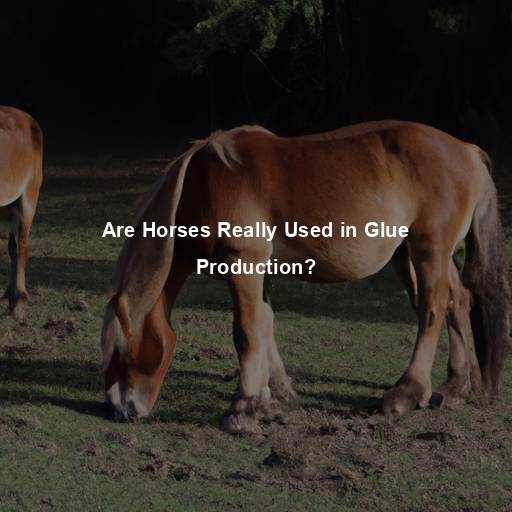Are Horses Really Used in Glue Production?
Last Updated on July 26, 2023 by Evan
Contents [hide]
- 1 Unveiling the Truth Behind a Common Myth
- 1.1 Debunking the Myth: Horses and Glue
- 1.2 The Modern Glue Industry
- 1.3 Animal By-Products: A Different Story
- 1.4 The Ethical Dimension: Animal Rights and Glue Production
- 1.5 Animal Welfare Regulations
- 1.6 The Importance of Transparency
- 1.7 Sustainable Alternatives: A Step Towards Progress
- 1.8 The Manufacturing Process
- 1.9 The Many Faces of Glue: Different Types and Applications
- 1.10 Looking Ahead: Innovations and Trends in the Glue Industry
- 2 FAQs
Unveiling the Truth Behind a Common Myth
There’s one burning question that has sparked a whirlwind of curiosity and bewilderment: do horses actually play a role in the production of glue? This timeless myth has caught the attention of animal enthusiasts and advocates, leaving them perplexed and eager for answers. In this captivating article, we embark on a profound exploration of this perplexing topic, unraveling the truth and unraveling the misconceptions that surround the enigmatic glue industry. Brace yourself for a mind-bending ride as we embark on this illuminating odyssey together!
Debunking the Myth: Horses and Glue
For centuries, a peculiar association between horses and glue production has fascinated the collective imagination. Across the intricate tapestry of popular culture, from the silver screen to whispered tales of the city, this enigmatic myth has taken root and grown resilient over time. It has captivated minds, leading them astray into believing that noble equines make the ultimate sacrifice for the sake of adhesive manufacturing. Yet, to unravel this perplexing tapestry of conjecture, one must venture into the realm of truth and discover a reality far removed from the captivating tales that have woven themselves into our collective consciousness.
The Historical Context
To understand the origin of this myth, we need to delve into history. In the past, horses played a significant role in various industries, including transportation and agriculture. As a result, when horses passed away or became unfit for work, their remains were repurposed for different purposes, including glue production. This historical connection between horses and glue has given rise to the misconception that horses are still used today.
The Modern Glue Industry
In a dizzying whirlwind of progress, the landscape of the glue industry has transformed into something unrecognizable from its humble origins. From the era of ancient animal-derived concoctions to the present day, where synthetic marvels dominate, the glue production realm has morphed into a perplexing realm of synthetic materials and chemical wizardry. No longer chained to the reliance on animal products, today’s adhesive formulas flaunt their origins in petroleum, resins, and polymers, revolutionary sources that offer unparalleled efficiency and economic prowess. It’s a head-spinning journey of evolution that leaves one both bewildered and fascinated by the boundless possibilities of modern adhesive technology.
Animal By-Products: A Different Story
When it comes to the origin of the gummy stuff that holds things together, there’s more to it than meets the eye. While it’s true that animals play a role in the production of certain adhesives, let’s not get carried away with the horse glue myth. Gelatin, a key ingredient in some glues, does come from animals, but it’s not just horses. Cows, pigs, and a whole menagerie of other creatures also contribute to this sticky situation.
The Ethical Dimension: Animal Rights and Glue Production
The ethical implications surrounding glue production have been a topic of concern for animal rights advocates. While horses may not be directly involved, the use of animal by-products raises questions about the treatment of animals and the sustainability of such practices. It is crucial for consumers to be aware of the ingredients in the products they purchase and make informed choices based on their personal values.
Animal Welfare Regulations
In a bid to uphold moral obligations towards the well-being of animals, governments and regulatory authorities have forged a path paved with stringent regulations to safeguard animal welfare across a wide array of industries. Stepping into the spotlight is the glue industry, where conscientious companies must navigate a labyrinthine maze of guidelines aimed at preventing any undue suffering inflicted upon our fellow creatures. Battling perplexity, these companies must remain steadfast in their commitment to compliance, adhering to rigorous quality control measures and sourcing protocols that serve as an armor of protection for the voiceless beings that share our world.
The Importance of Transparency
In a rapidly evolving era of heightened consumer awareness, the demand for transparency has taken center stage. As conscientious individuals become more discerning about the products they bring into their lives, manufacturers in the realm of glue have recognized the pivotal importance of providing comprehensive information. By shedding light on every aspect, from the origins of raw materials to the intricate production processes, these companies empower consumers to make well-informed decisions that resonate with their personal values and principles. This commitment to transparency establishes a powerful connection between glue manufacturers and the individuals who seek genuine accountability in every purchase they make.
Sustainable Alternatives: A Step Towards Progress
In this evolving era of conscious consumerism, the glue industry is embarking on a transformative journey, committed to redefining its ethical framework. A tidal wave of environmental awareness has ushered in a demand for products that not only adhere to sustainable principles but also embrace compassion towards animals. Responding to this paradigm shift, numerous companies are now channeling their resources towards groundbreaking research initiatives, striving to pave the way for innovative alternatives that minimize the dependence on animal-derived components and propel us towards a more harmonious and sustainable tomorrow.
The Manufacturing Process
Breaking down the myth of horses and glue production, it’s time to delve into the captivating world of adhesive manufacturing. With a fascinating concoction of intricate steps, this process brings forth the remarkable product that seamlessly integrates into our everyday routines. From inception to completion, these key stages contribute to the extraordinary adhesives we rely on.
Raw Material Sourcing
The first step in glue production is sourcing the necessary raw materials. As mentioned earlier, modern adhesives primarily rely on synthetic compounds derived from petroleum, resins, and polymers. These materials are obtained through a combination of chemical synthesis and extraction processes, ensuring consistency and quality in the final product.
Formulation and Mixing
When it comes to creating adhesives, there’s a fascinating process that takes place after the raw materials are gathered. It’s like a carefully choreographed dance of ingredients and proportions, all aimed at bringing out the perfect adhesive properties. Each adhesive has its unique requirements, as the bonding strength, flexibility, and drying time all play a crucial role in determining the final product. It’s a complex balance of science and artistry that never fails to perplex and captivate.
Chemical Reactions and Curing
After the formulation is complete, the adhesive mixture undergoes chemical reactions that promote bonding and curing. These reactions enable the adhesive to transform from a liquid or semi-liquid state to a solid state, creating a strong and durable bond. The curing process may involve exposure to heat, pressure, or moisture, depending on the type of adhesive being produced.
Quality Control and Testing
When it comes to the intricate process of manufacturing, utmost precision is maintained to guarantee the adhesives’ quality meets the highest standards. At different phases, samples are carefully extracted to evaluate crucial factors like viscosity, adhesion strength, and drying time. Meticulous testing protocols are in place to unearth any possible concerns and secure the ultimate output’s uniformity and dependability.
The Many Faces of Glue: Different Types and Applications
Glue comes in various forms and serves a wide range of purposes. Let’s explore some of the most common types of glue and their applications in different industries and everyday life.
White Glue (PVA)
You know that sticky situation when you’re knee-deep in an arts and crafts project or trying to mend something in your home? Well, let me introduce you to our savior – white glue! This magical potion, known as polyvinyl acetate (PVA) glue to the scientists, is an adhesive marvel that can flex its muscles in arts and crafts, woodworking, and even those pesky household repairs. Yep, it’s the ultimate multi-tasker, forming mighty bonds with all sorts of porous materials like paper, fabric, wood, and ceramics.
Super Glue (Cyanoacrylate)
When it comes to sticking things together like a magician’s favorite trick, look no further than the incredible power of super glue. This fast-acting adhesive, also known as cyanoacrylate, boasts a mysterious ability to form an unbreakable bond between all sorts of non-porous materials, from trusty metals to resilient plastics, from flexible rubber to delicate glass. With the speed of a rocket launch and the strength of a superhero, super glue sets in an instant, creating a formidable connection that can withstand the fiery heat of high temperatures and the thunderous force of impacts. It’s no wonder this versatile and awe-inspiring adhesive has become the undeniable champion of countless households and industrial settings, leaving its users spellbound by its exceptional capabilities.
Epoxy Resin
Epoxy resin is a two-part adhesive that consists of a resin and a hardener. When mixed together, these components undergo a chemical reaction that results in a strong and durable bond. Epoxy is widely used in construction, automotive, and marine industries due to its exceptional strength, resistance to heat and chemicals, and ability to bond various materials, including metal, concrete, and fiberglass.
Hot Glue
Hot glue, or hot melt adhesive, is a thermoplastic adhesive that is applied in a molten state using a glue gun. It solidifies quickly upon cooling, creating a strong bond. Hot glue is commonly used in crafts, DIY projects, and packaging due to its fast-setting time and versatility in bonding materials such as fabric, plastics, and foam.
Wood Glue
As the name suggests, wood glue is specifically designed for bonding wood surfaces. It is formulated to penetrate the wood fibers, creating a strong bond that is resistant to moisture and temperature changes. Wood glue comes in different variations, including interior and exterior types, providing options for various woodworking projects and applications.
Looking Ahead: Innovations and Trends in the Glue Industry
As technology continues to advance, the glue industry is not exempt from innovation and evolving trends. Here are some key areas where the industry is experiencing exciting developments:
Sustainable and Eco-Friendly Adhesives
As the world becomes increasingly conscious of the environment, the demand for sustainable and eco-friendly adhesive solutions is skyrocketing. In order to meet this pressing need, manufacturers are revolutionizing their approach by venturing into uncharted territories of raw materials that tick all the right boxes – they’re renewable, biodegradable, and less dependent on fossil fuels. But the sustainability train doesn’t stop there! These forward-thinking companies are also working tirelessly to minimize the carbon footprint associated with the manufacturing process.
Bio-Based Adhesives
Bio-based adhesives, derived from natural sources such as plants and agricultural waste, are gaining traction in the industry. These adhesives offer a renewable and environmentally friendly alternative to traditional petroleum-based adhesives. They exhibit comparable performance while minimizing the environmental impact.
Smart Adhesives
The landscape of innovation has witnessed an intriguing uprising with the emergence of smart adhesives, driven by the spectacular progress in materials science and nanotechnology. These next-generation adhesives have embarked on a disruptive journey, boasting mind-boggling characteristics like the astonishing ability to heal themselves, unparalleled versatility in adjusting to ever-changing surroundings, and even the unlikely capability to conduct electricity. As we delve into these cutting-edge breakthroughs, it becomes undeniable that these remarkable adhesives are set to revolutionize industries spanning from electronics to aerospace and healthcare, leaving us all in a state of awe and anticipation.
Biodegradable and Removable Adhesives
In today’s fast-paced world, the demand for adhesives that leave no trace and cause no harm is on the rise. Enter the realm of biodegradable and removable adhesives – an innovative solution to meet the ever-evolving needs of various industries. With their remarkable ability to provide convenience and adaptability, these adhesives have become the go-to choice for those seeking temporary bonding or effortless repositioning.
FAQs
Are horses used to make glue?
Contrary to popular belief, the notion that horses are directly utilized to create glue is a misnomer. While horses did play a crucial role in the bygone era of glue manufacturing, it is imperative to acknowledge the remarkable evolution of this industry. With advancements in technology and changing methods, the involvement of horses in contemporary glue production has diminished significantly, rendering it a rarity. So fear not, dear readers, the era of equine glue is but a distant memory.
How was glue made from horses in the past?
In earlier times, our hairy friends, the horses, found themselves unwittingly entangled in the rather sticky business of glue production. Fascinatingly, their hooves and bones – the very essence of their equine existence – were subjected to a rather boisterous boiling process at rendering plants, causing them to yield the coveted gelatin. This gelatin, after a most elaborate transformation, ultimately found its way into the concoction of glue. It must be emphasized, however, that this peculiar method of glue creation has long since lost its popularity, yielding to more modern approaches.
What materials are used to make glue today?
In the ever-evolving world of adhesion, the once-simple art of glue-making has taken a perplexing twist. Today, the trusty horse, once the backbone of glue production, has taken a backseat. Instead, synthetic marvels and peculiar animal derivatives like bones and hides have climbed aboard the glue-making train. But wait, the strangeness doesn’t stop there! Plant-based potions, harnessing the power of starch and cellulose from botanical sources, have also joined the sticky brigade. As technology marches forward, the glue-making landscape fills with a burst of unpredictability, pushing the boundaries of what we thought possible.
Are there any regulations or ethical considerations regarding glue production?
When it comes to the production of glue, ethical considerations and regulations take center stage. Governments around the world have put forth a set of rules and guidelines that govern the treatment and handling of animals involved in various industries, including glue manufacturing. These measures are put in place to ensure that animals are treated with the utmost care and respect throughout the production process. Moreover, in tune with the shifting tide of consumer consciousness, many businesses are choosing to explore alternative materials that bypass animal by-products while prioritizing sustainability and animal welfare.
Can glue be made without using animals?
It’s true – you don’t need animals to make glue anymore! In fact, the world of glue production has undergone some amazing changes in recent times. Gone are the days when animals were the go-to source for glue ingredients. Now, we have a wide range of plant-based adhesives that are completely free from any animal by-products. And if that wasn’t impressive enough, synthetic compounds have also stepped into the spotlight, eliminating the need for animal-based materials altogether. This shift towards more eco-friendly and cruelty-free options is not only a sign of the times but also a testament to our growing consciousness about the world around us.







